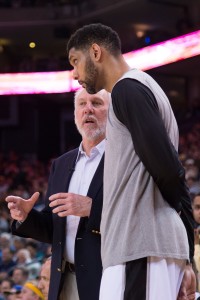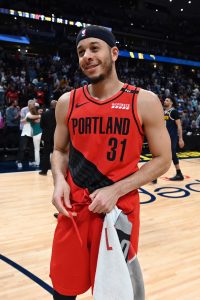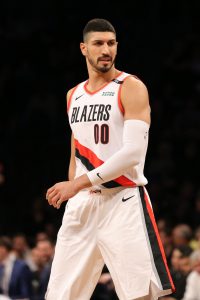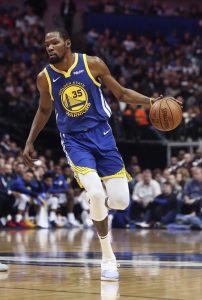NBA teams have spent record-setting amounts of money on free agents this summer, but many of the most lucrative contracts that have been signed within the last week weren’t free agent deals at all — they were contract extensions.
Extensions, of course, don’t involve adding a new player to the roster. By extending a contract, a team ensures that a current player will remain locked up for multiple years to come. Although a contract extension may not change the club’s outlook on the court, it can have a major impact on that team’s salary cap situation for the next several summers.
Rookie scale extensions are the most common form of contract extension, and Ben Simmons and Jamal Murray became the first two members of the 2016 draft class to sign those. However, they won’t be the last. There are many other players eligible for new deals up until the mid-October deadline, and it’s common for about four to eight players entering the final year of their respective rookie contracts to sign extensions.
[RELATED: Players eligible for rookie-scale extensions]
While they’ve historically been less common than rookie-scale extensions, veteran extensions are happening more frequently these days, with the league’s current Collective Bargaining Agreement expanding the rules for eligibility and creating some additional incentives for star players to sign new deals before they reach free agency. Seven players signed veteran extensions during the 2017/18 league year, and three more signed them in 2018/19.
Listed below are the players who have finalized contract extensions so far in the 2019/20 league year. This list, which can be found on the right-hand sidebar under “Hoops Rumors Features” on our desktop site (or on the “Features” page in our mobile menu) will be kept up to date throughout the offseason — and throughout the ’19/20 regular season if any veteran players ink an extension at that point.
Veteran extensions:
- Damian Lillard (Trail Blazers): Four years, 35% maximum salary (story). Projected value of $196,000,000. Designated veteran extension. Starts in 2021/22.
- C.J. McCollum (Trail Blazers): Three years, $100,000,000 (story). Starts in 2021/22.
- Draymond Green (Warriors): Four years, $99,666,363 (story). Includes 15% trade kicker. Starts in 2020/21.
- Eric Gordon (Rockets): Four years, $75,574,356 (story). Fourth year is non-guaranteed. Starts in 2020/21.
- Bradley Beal (Wizards): Two years, $71,764,428 (story). Includes 15% trade kicker, second-year player option. Starts in 2021/22.
- Royce O’Neale (Jazz): Four years, $36,000,000 (story). Fourth year is partially guaranteed. Starts in 2020/21.
- Dillon Brooks (Grizzlies): Three years, $35,000,000 (story). Starts in 2020/21.
- Dwight Powell (Mavericks): Three years, $33,240,375 (story). Starts in 2020/21.
- Cedi Osman (Cavaliers): Four years, $30,800,000 (story). Fourth year is non-guaranteed. Starts in 2020/21.
- Kyle Lowry (Raptors): One year, $30,000,000 (story). Includes $500K All-Star bonus. Starts in 2020/21.
- Andre Iguodala (Heat): Two years, $30,000,000 (story). Includes 7.5% trade kicker, second-year team option. Starts in 2020/21.
- Joe Ingles (Jazz): One year, $12,436,364 (story). Includes $1.2MM in incentives. Starts in 2021/22.
Rookie scale extensions:
- Ben Simmons (Sixers): Five years, 25% maximum salary (story). Projected value of $168,200,000. Starting salary can be worth up to 30% of the cap if Simmons earns All-NBA honors in 2020 (full details). Includes 15% trade kicker. Starts in 2020/21.
- Jamal Murray (Nuggets): Five years, 25% maximum salary (story). Projected value of $168,200,000. Starting salary can be worth up to 30% of the cap if Murray earns All-NBA honors in 2020 (full details). Starts in 2020/21.
- Pascal Siakam (Raptors): Four years, 25% maximum salary (story). Projected value of $129,920,000. Starting salary can be worth between 28-30% of the cap if Siakam earns All-NBA or MVP honors in 2020 (full details). Starts in 2020/21.
- Jaylen Brown (Celtics): Four years, $103,000,000 (story). Includes $12MM in incentives. Starts in 2020/21.
- Buddy Hield (Kings): Four years, $86,000,000 (story). Includes $20MM in incentives (full details). Starts in 2020/21.
- Domantas Sabonis (Pacers): Four years, $74,900,000 (story). Includes $10.4MM in incentives. Starts in 2020/21.
- Dejounte Murray (Spurs): Four years, $64,000,000 (story). Includes $6MM in incentives (full details). Starts in 2020/21.
- Caris LeVert (Nets): Three years, $52,500,000 (story). Starts in 2020/21.
- Taurean Prince (Nets): Two years, $25,250,000 (story). Includes $3.7MM in incentives. Starts in 2020/21.

 ; $375,000 (
; $375,000 (
